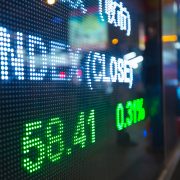The Dark Side of Index Investing
While I have been a fan of investing in index funds and ETF’s for some time, I always start to get wary when some form of investment becomes all the rage. At the moment, “Index investing” is widely touted to solve all manner of investment challenges and 16 of the 25 largest mutual funds are index funds. History has taught me that when there is a widespread and cheery group consensus about a particular investment, it’s highly likely to soon go into decline. So I’ve been looking for what could go wrong with investing in index funds. What I found surprised me; so I thought it worth sharing.
The primary weakness stems from the fact that almost all of the index funds are weighted according to the market capitalization of the underlying companies that comprise the index. This means that the larger the market capitalization of a company, the more it influences the index. So when an investor puts $100 into a S&P 500 Index fund that is comprised of 500 individual companies, it is mandated that Apple gets $3.85 of that, Google gets $2.80, Microsoft gets $2.60, Amazon gets $1.90 and so on. But the representation of the 500 companies varies substantially, with over half of the 500 companies in the index getting $.10 or less. News Corp, which is one of the smaller companies in the S&P Index, is allocated less than a penny.
The net result of this forced allocation is that it puts a disproportional percentage of the fund into an increasingly small number of stocks. The larger the market cap these stocks get, the more investment funds they automatically garner. Note that this allocation is not an investment decision reached by sanguine money managers. Rather, it is mandated simply by the formula that defines the index, which is weighted according to the market capitalization.
How concentrated are these indexes now? The top 5 companies in the S&P 500 index are 13% of that index and the top 25 stocks are 34%. The top 5 companies in the Nasdaq 100 Index, which is represented by the QQQ ETF, comprise a whopping 42% of that index. Even the so-called “total market indexes” from Vanguard and others have very high concentrations. In the Vanguard Total Stock Market Index, 5 companies (Apple, Microsoft, Amazon, Facebook and Google) comprise 10% of the portfolio, and 25 companies are 28%. This is hardly a “total stock market” representation. What’s even more alarming is that the same 5 companies (all tech stocks) are the top holdings of pretty much ALL of the stock market index funds.
There are many potential problems with this type of high concentration. The largest issue is what I believe is a severe mismatch between what the investors in index funds think they are buying and what they are actually getting. I think that almost all investors in these funds think they are getting a broad and wide representation of companies across the economic spectrum. While there are technically a large number of companies in these index portfolios, because of the market-weighted formula, most of the companies have little representation and influence on the index.
While even Warren Buffett, whom I have the highest admiration for, has recommended index funds, I don’t think he would recommend that everyone go out and put 10-15% of their investments in the exact same 5 stocks. If these index funds were normal mutual funds, there would be shock and disbelief from Barron’s and the Wall St Journal, complete with lengthy stories about how all the fund managers were “lemmings” whose herd instincts had gotten the best of them. The evidence would be that all of them own the same 5 stocks in roughly the same proportion.
Making things even more precarious is the current gushing optimism that market pundits are heaping upon those same five mega-cap stocks. In one 5 minute viewing of CNBC the other day, the praise I heard about Amazon oscillated between licentious and lascivious. My thought was, “my we’ve come quite some ways from the time 15 years ago when the consensus was that Amazon was going bankrupt.” While these top 5 are fine companies at the moment, the market is a fickle mistress and, given time, her attentions wander. That is a certainty.
As I mention in my book “The Start-Up J Curve,” the technology sector tends to follow a boom-bust cycle, at one moment in time things look incredible and just keep getting better, and the next moment disappointment reigns. So the fact that the top 5 names are technology companies is a bit unnerving.
When most people buy a market index fund or exchange traded fund (ETF), such as the S&P 500 as represented by the SPDR S&P 500 or the Vanguard 500 Index fund, they believe that they are buying a single investment that is highly representative of the stock market. While these funds do a fine job mirroring their various indexes, at some point I think it’s worth asking if the index itself is an ideal thing to own.
There are over 6,000 stocks on the NYSE and the Nasdaq and I would hazard that 5,000 or over 80% of those are quickly becoming under-owned, especially small-cap stocks. As more and more investment dollars are funneled away from smaller stocks towards the larger stocks, eventually this dynamic should present opportunity for stock picking among the smaller, low market cap stocks. I do think that index funds have many strengths and I own a number of them. I also own many of the top 10 names individually. This means I own the same names through multiple vehicles, resulting in a fairly concentrated portfolio. On the surface, it looks like I am much more diversified than I really am. I am fully aware that it is very hard indeed for the average mutual fund to beat a pure index on an after-tax basis over time. But I suspect that going forward, “stock picking” may make some comeback. There may be other options that can do better. For example, an equal weighted index of 1,000 or so small-cap stocks may do well. In fact, I’m considering just making my own “index” of sorts by buying equal amounts of 100-200 small cap stocks.
Index investing is so popular right now that it strikes me as approaching bubble proportions. The thing about bubbles is that they almost always overshoot, lasting far longer than you would expect, so it’s really hard to figure out when the current investment fad ends. But end it will, because everyone can’t be on the same side of a boat without it tipping and dumping you into the dark blue cold water of the abyss. It’s time to consider what might be wrong with the crowd consensus and opine where better opportunities may lie.



